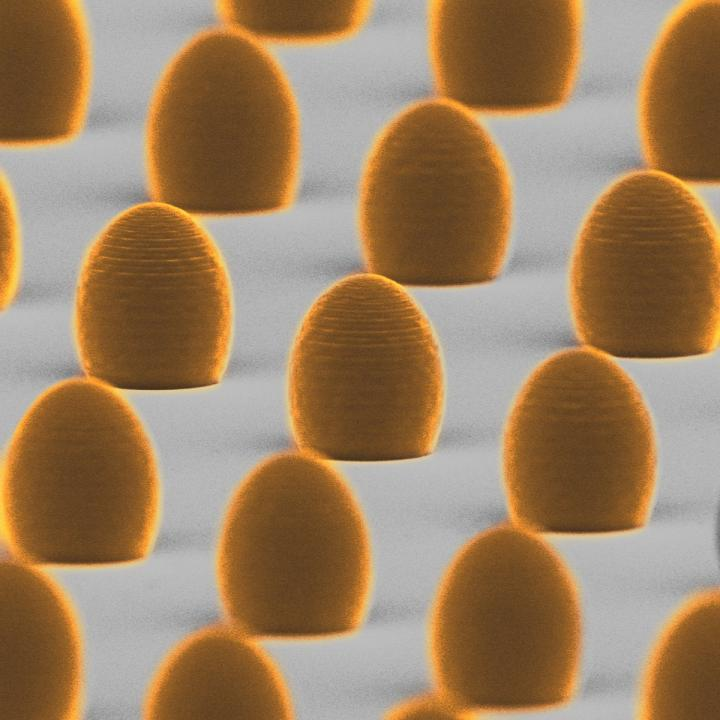May 8 2020
Additive manufacturing can be described as a method that involves producing a final three-dimensional object by successive addition of new layers of building material to already-deposited layers.
 Scanning electron microscope image of 3D-printed aspherical microlenses. Thanks to short printing time, it is possible to produce hundreds of such microlenses on one sample. Image Credit: Aleksander Bogucki, Łukasz Zinkiewicz, Magdalena Grzeszczyk, Wojciech Pacuski, Karol Nogajewski, Tomasz Kazimierczuk, Aleksander Rodek, Jan Suffczyński, Kenji Watanabe, Takashi Taniguchi, Piotr Wasylczyk, Marek Potemski, and Piotr Kossacki.
Scanning electron microscope image of 3D-printed aspherical microlenses. Thanks to short printing time, it is possible to produce hundreds of such microlenses on one sample. Image Credit: Aleksander Bogucki, Łukasz Zinkiewicz, Magdalena Grzeszczyk, Wojciech Pacuski, Karol Nogajewski, Tomasz Kazimierczuk, Aleksander Rodek, Jan Suffczyński, Kenji Watanabe, Takashi Taniguchi, Piotr Wasylczyk, Marek Potemski, and Piotr Kossacki.
In the recent past, commercial 3D printers have undergone rapid advancement, similar to the 3D-printers materials, such as transparent media with high optical quality. These developments pave the way for new possibilities in various fields of science and technology, such as metamaterials studies, medicine, biology, micro-optics, and robotics.
At the Faculty of Physics, University of Warsaw, Poland, researchers have developed tiny lenses (measuring as small as a fraction of the diameter of a strand of human hair) that can be produced easily through laser 3D printing method on top of different materials, such as fragile novel 2D graphene-like materials.
The new lenses increase the extraction of light from semiconductor samples and reshape its outgoing portion into an ultra-narrow beam. This property avoids the need for integrating a bulky microscope objective into the experimental configuration while carrying out optical measurements of single nanometre-sized light emitters (such as quantum dots), which could not be avoided to date.
The size of a standard microscope objective employed in such a study is approximately that of a hand’s breadth, with a weight of up to one pound (or 0.5 kg). The objective must be positioned at a distance of about one-tenth of an inch (a few millimeters) from the sample to be analyzed.
These factors restrict several types of modern experiments to a considerable extent, such as measurements in pulsed high magnetic fields, in microwave cavities or at cryogenic temperatures, which can be lifted easily by the new lenses.
The fast nature of the 3D-printing method renders it simple to generate hundreds of microlenses on a single sample. When these microlenses are arranged into regular arrays, a convenient coordinate system is realized, which precisely denotes the location of a selected nanoobject and enables multiple measurements of the object in various laboratories across the globe.
The vital capability of employing the same light emitter enables more time-efficient studies and hypothesis testing. Particularly, researchers can focus fully on designing and carrying out a new experiment on the nanoobject investigated earlier, rather than performing a time-consuming analysis of thousands of other nanoobjects before they can find an equivalent to the earlier one.
It is possible to adapt the shape of the proposed microlenses easily to what is called the 2.5D microfabrication technique. The objects that fulfill its prerequisites can be created over large-scale surfaces by pressing a patterned stamp against the layer of material of which they are to be made.
The 2.5D fabrication protocol is specifically appealing from the standpoint of prospective applications of the microlenses since it can be readily scaled up—a crucial factor for potential future industrial use.
Journal Reference:
Bogucki, A., et al. (2020) Ultra-long-working-distance spectroscopy of single nanostructures with aspherical solid immersion microlenses. Light: Science & Applications. doi.org/10.1038/s41377-020-0284-1.